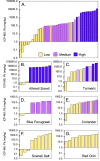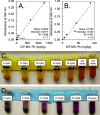Assessing Analytical Methods for the Rapid Detection of Lead Adulteration in the Global Spice Market
- PMID: 36343212
- PMCID: PMC9730856
- DOI: 10.1021/acs.est.2c03241
Assessing Analytical Methods for the Rapid Detection of Lead Adulteration in the Global Spice Market
Abstract
Lead adulteration of spices, primarily via Pb chromate compounds, has been documented globally as a growing public health concern. Currently, Pb detection in spices relies primarily on expensive and time-consuming laboratory analyses. Advancing rapid Pb detection methods, inclusive of their accuracy and precision, would improve field assessments by food safety inspectors, stakeholders, and the public in the hope of reducing Pb exposure risks at its source. Here, we present two field procedures for Pb detection: portable X-ray fluorescence analysis (pXRF) and a simple colorimetric test. We assess their efficacy to detect Pb and its chemical form in seven spice types, including powders, spice-salt mixtures, and dried roots, compared to the proven laboratory technique, inductively coupled plasma mass spectrometry (ICP-MS). Lead concentrations measured using pXRF and ICP-MS were within 5% of each other for spice powders and 24% for dried roots. By pXRF, spice samples were analyzed within collection plastic bags without preparation, resulting in a detection limit of 2 mg Pb/kg for spice powders, which is comparable to national food standards. The colorimetric test utilized here targets hexavalent chromium, making the method selective to Pb chromate adulteration assuming that this is its dominant source in spices. Color development, and thus detection, was observed when Pb concentrations exceeded approximately 5-70 mg/kg in dried turmeric roots and 1000 mg/kg in spice powders; however, it was ineffective for the spice-salt mixture. We show that pXRF analysis and a colorimetric assay provide information that may improve field decisions about Pb adulteration in a range of spice types, helping to minimize Pb exposure.
Keywords: ICP-MS; Pb; adulteration; colorimetry; lead chromate; pXRF; rapid detection; spices.
Conflict of interest statement
The authors declare no competing financial interest.
Figures





Similar articles
-
Turmeric means "yellow" in Bengali: Lead chromate pigments added to turmeric threaten public health across Bangladesh.Environ Res. 2019 Dec;179(Pt A):108722. doi: 10.1016/j.envres.2019.108722. Epub 2019 Sep 6. Environ Res. 2019. PMID: 31550596
-
Reductions in spice lead levels in the republic of Georgia: 2020-2022.Environ Res. 2024 Jun 1;250:118504. doi: 10.1016/j.envres.2024.118504. Epub 2024 Feb 15. Environ Res. 2024. PMID: 38367836
-
Nutrient and toxic elements in soils and plants across 10 urban community gardens: Comparing pXRF and ICP-based soil measurements.J Environ Qual. 2022 May;51(3):439-450. doi: 10.1002/jeq2.20346. Epub 2022 May 4. J Environ Qual. 2022. PMID: 35419845
-
Overview of Analytical Tools for the Identification of Adulterants in Commonly Traded Herbs and Spices.J AOAC Int. 2019 Mar 1;102(2):376-385. doi: 10.5740/jaoacint.18-0389. Epub 2019 Jan 15. J AOAC Int. 2019. PMID: 30646970 Review.
-
Spice and Herb Frauds: Types, Incidence, and Detection: The State of the Art.Foods. 2023 Sep 8;12(18):3373. doi: 10.3390/foods12183373. Foods. 2023. PMID: 37761082 Free PMC article. Review.
Cited by
-
Assessment of Heavy Metal Contents in Some Common Spices Available in the Local Market of North Shewa Zone, Oromia Regional State, Ethiopia.Biol Trace Elem Res. 2024 Jul;202(7):3349-3361. doi: 10.1007/s12011-023-03921-8. Epub 2023 Nov 16. Biol Trace Elem Res. 2024. PMID: 37973776
-
Quantitative immunosensor for dibenz[a,h]anthracene on-site detection in oilfield chemicals based on computer-aided antibody.Mikrochim Acta. 2025 Mar 20;192(4):245. doi: 10.1007/s00604-025-07035-x. Mikrochim Acta. 2025. PMID: 40111571
-
Africa, an Emerging Exporter of Turmeric: Combating Fraud with Rapid Detection Systems.Foods. 2025 Apr 30;14(9):1590. doi: 10.3390/foods14091590. Foods. 2025. PMID: 40361671 Free PMC article. Review.
-
Recent Progress on Fluorescent Probes in Heavy Metal Determinations for Food Safety: A Review.Molecules. 2023 Jul 27;28(15):5689. doi: 10.3390/molecules28155689. Molecules. 2023. PMID: 37570660 Free PMC article. Review.
References
-
- Ishida M. L.; Greene V.; King T.; Sheridan R.; Luker J.; Oglesby D. V.; Trodden J.; Greenberg J.. Regulatory Policies for Heavy Metals in Spices – a New York Approach. J. Regul. Sci. 2022, 10, 1–12.10.21423/jrs-v10i1ishida - DOI
Publication types
MeSH terms
Substances
LinkOut - more resources
Full Text Sources

